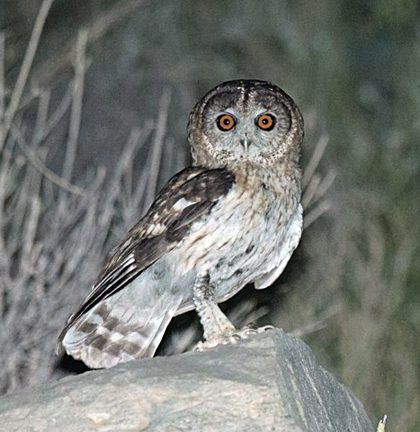Who’s Hooting? New Owl Discovered by the Sound of Its Voice
By Gustave Axelson
January 15, 2014

Who’s hooting? Audio recordists serendipitously discover the Omani Owl—and like many newly discovered species, this bird is already in need of conservation agnus Robb was in Arabia to listen to owls. But in nearly two decades of recording bird sounds, he had never heard hooting like this.
Robb, a Scottish musician turned gatherer of bird audio, was in Oman last March to collect vocalizations of the Pallid Scops-Owl. It was part of the latest project by The Sound Approach, a European collective of bird audio recordists, to publish a book and CD package to be entitled Undiscovered Owls.
And there, in the dry valley of a wadi in the Al Hajar mountains, Robb made a discovery: a different kind of owl, not a Pallid Scops, hooting so softly he couldn’t hear it with his bare ears. But through headphones listening to a pair of remote microphones, he heard four nearly inaudible hoots in a three-part rhythm, almost like an owly version of the wedding march: Here comes the bride.
Follow-up visits to Oman by Robb and fellow Sound Approach colleagues resulted in more recordings of this mystery owl. Then in May, Dutch audio recordist Arnoud van den Berg snapped the first photos of a brown, round-headed owl unlike any other known to inhabit the Arabian Peninsula. Back at their homes, Robb, van den Berg, and the rest of the Sound Approach team crosschecked their mystery owl recordings against the vocalizations of every other known species, using the Cornell Lab of Ornithology’s Raven Pro sound-analysis software and tapping into audio archives such as the vast trove of online recordings at the Cornell Lab’s Macaulay Library.
In October, the birding journal Dutch Birding published their findings—the scientific discovery of a new owl species, the Omani Owl (tentatively named Strix omanensis). It was the first new bird species found in the Western Palearctic region (an ecozone running from Europe to North Africa to Arabia) in 40 years.
“In terms of North American birding, it’d be like finding a new species in Mexico,” says Macaulay Library assistant curator Matt Medler, who worked with Robb to archive the Omani Owl recordings at the Cornell Lab.
“We decided that the best public place in the world for conserving sound-recordings was the Macaulay Library,” says van den Berg, who has archived nearly 3,800 of his recordings at the Cornell Lab since the 1970s. “We know very well that its archiving is of the highest quality.”
Yet, the addition of a new bird species to the Macaulay archives was not an unusual occurrence. About five to seven new bird species are discovered every year, according to the Handbook of the Birds of the World. Just this past summer, the Macaulay Library archived recordings of 10 new bird species from Brazil, including the Campina Jay—a new Cyanocorax species that measures more than a foot long, hardly an inconspicuous bird.
But these new jays are already threatened with extinction due to habitat loss. Their entire range on the edge of Amazonian savannas could be cleared of natural vegetation within 30 to 50 years. Their plight reminds many ornithologists of the Po’o-uli, a Hawaiian honeycreeper that immediately became one of the world’s most endangered birds upon being discovered on the forested northeast slopes of a Maui volcano in 1973. The last wild Po’o-uli was seen in 2004, and there are none in captivity.
According to BirdLife International, 11 of 50 new bird species discovered between 2000 and 2009 are listed as endangered—and 6 of those species are critically endangered.
“It’s entirely possible that there are undescribed bird species going extinct without ever being known to science,” says Greg Budney, Macaulay Library audio curator.
A sense of urgency for conservation drove Robb, van den Berg, and Sound Approach to rush the evidence for their new owl species to publication as fast as possible, on the basis of audio recordings and photographs but without a traditional type specimen in hand for genetic analysis. “We had no idea, and still do not know, how rare the species is,” says van den Berg. But his team does know that only six Omani Owls were heard hooting from the clifftops of a single wadi. And only officially recognized species qualify for threatened species listing by the International Union for Conservation of Nature. “It was no option to wait, as we wanted to have conservation measures in place as soon as possible,” he says.
The announcement of the discovery of the Omani Owl was met with initial disbelief by many ornithologists, which van den Berg says is understandable. “Nobody, including us, expected that a new species, other than a cryptic one split by DNA analysis, could still be hiding in the Western Palearctic sensu lato, a region that has been visited by many biologists and explorers in the past 100 to 150 years,” he says. The discovery underscores the importance of audio monitoring for assessing bird populations even in wellstudied habitats. It’s not that Magnus Robb was the first person, even the first birder, to stand in a wadi at night when an Omani Owl was hooting, but he was the first one there wearing headphones, with a microphone and the ability to amplify natural sounds several times louder than normal levels.
Which begs the question: What else could be out there hooting in the night, as yet undetected?


All About Birds is a free resource
Available for everyone,
funded by donors like you









